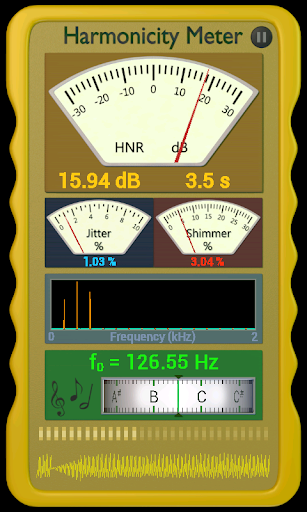- Applications
- Music & Audio
Harmonicity Meter
Images



Introduction
Measure the Harmonic to Noise Ratio (Harmonicity) from your microphone.
Harmonicity is a measure of the sound energy in the harmonics relative to the rest of the spectrum.
Harmocity varies with age, gender & which vowel you pronounce. Higher harmonicity values indicate a purer sound. Whilst lower jitter and shimmer values indicate a purer sound.
This meter is supposed to be used with a continuous consistent sound, e.g. Pronoucing a vowel, or a tone from a speaker/instrument. Rapidly changing tone/sound will give nonsensical output.
FOR INDICATION ONLY. Harmonicity will vary depending on how close the source is to the microphone. Microphone sensitivity varies with frequency and from device to device. Even amoungst scientific literature, it is difficult to find consistency in absolute reported values.
Jitter is a measure of the frequency variation of the sound. The relative jitter is shown as a %.
Shimmer is a measure of the amplitude variation of the sound. The relative shimmer is shown as a %.
Autodetects sound – App will only start measuring when a sound is detected.
Averaging - After 0.7s, the app will start averaging the Harmonicity, Jitter, Shimmer and freqency values. This will continue until the sound is stopped at which point the last 0.7s of data is removed from the averaged values.
Musical Note – The current detected frequency is converted into a note based on western 12 tone equal temperament. Use to tune your guitar or other instrument if you wish.
Pause button – Useful if in a noisy environment and measurement doesn't auto stop.
FFT Spectrum – Autoscaling Sound Intensity between 0 and 2 kHz.
Range: 100 Hz to 2 kHz fundamental harmonic frequency detection.
Technical bit:
The fast fourier transform (size 8192) is performed on the last 0.74s of data to produce a frequency spectrum (0 to 5.5 kHz with 1.35Hz resolution). This frequency spectrum is windowed between 100 and 4 kHz with linear fall offs to zero at 50 and 5 kHz. The fundamental frequency is determined from polynomial fitting to peaks. The harmonic energy is determined from the sum of the FFT signal at the harmonic freuquency plus 8 Hz either side. The noise is the sum of the rest of the FFT. The ratio of harmonic to noise energy is the Harmoicity and is displayed in decibels.
More technical details can be found on the website.
Related Applications










Users Also Installed
Similar Applications






















